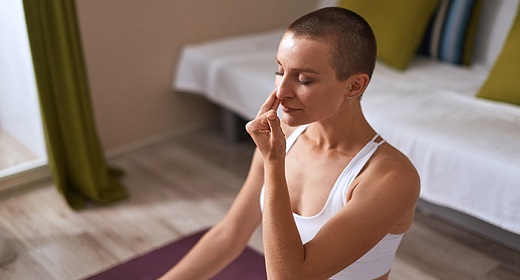by (Yoga Approved) There are many ways to combat anxiety, but perhaps none as quickly – and naturally – effective as certain forms of Pranayama…
Pranayama is conscious breathwork and is often used in yoga, mindfulness practices and meditation.
There are many forms of Pranayama, and this article focuses specifically on four effective types of Pranayama for anxiety.
The reason that Pranayama is so beneficial for combating anxiety is because breathing is already a key ingredient for calming mind and body. Think about when you’re afraid or stressed out. Your breath typically becomes quick and shallow – often confined to your chest.
Now, think about when you’re incredibly calm and relaxed. Your breathing is deeper, slower and more rooted in your ribs and belly.
As you read on to explore and try these four forms of Pranayama for anxiety, notice that you’ll bring specific attention to not just how you’re breathing, but also where your breathing is originating from.
Deep, calm breathing of any kind helps to take us out of our body’s “fight-or-flight” response that’s triggered from anxiety, and instead activate the parasympathetic nervous system’s “rest-and-digest” response.
Try Using Pranayama for Anxiety With These 4 Exercises:
Read on to learn about four effective forms of Pranayama for anxiety and practice along with our step-by-step tutorial!
1. Sama Vrtti Pranayama (Box Breathing)
Sama Vrtti Pranayama means “same breath” and is also commonly referred to as Box Breathing. It’s a simple and basic form of conscious breathwork that’s oh-so-effective for relieving anxiety.
This form of Pranayama for anxiety is popular because it’s incredibly calming and easy to do.
Let’s try it:
- Start in a comfortable seated position, sitting up tall
- Inhale through your nose for a slow count of four
- Hold the air in at the top for a breath (or a count of 1-2)
- Exhale through your nose for a slow count of four
- Hold the air out at the bottom for a breath (or a count of 1-2)
- Repeat the cycle for a full round of 10
- You can also increase the count from four to five, six or seven if you want longer, slower rounds
2. Dirga Swasam Pranayama (Complete Breath)
Also referred to as a three-part breath, Dirga Swasam is an easy and accessible form of Pranayama for anxiety and it feels as good as it works! The three parts of the body we’ll focus on during this breathwork are the abdomen, diaphragm, and upper chest (think collarbone region).
Dirga Swasam Pranayama boosts the oxygen supply in your body which in turn decreases stress and anxiety. This is also a great form of breathwork to use during your yoga or meditation practice for calming and centering the mind.
Let’s try it:
- Start in a comfortable seated position, sitting up tall
- Bring one hand to your low belly and place the other over your heart
- Begin breathing normally as you bring your awareness to your belly, ribs, and chest
- Start to slow down and deepen your breathing
- As you inhale, visualize the oxygen filling your abdomen, then lungs, all the way up to your collarbones
- As you exhale, visualize the oxygen slowly leaving from the top down (collarbones down to abdomen)
- Continue your slow, mindful three-part inhales and exhales for 10 rounds
3. Ujjayi Pranayama (Ocean Breath)
A fan favorite, Ujjayi is both a fun and effective form of Pranayama for anxiety (and also mental focus). We’re moving into the more complex forms of Pranayama in that Ujjayi requires a bit of technique, but it only takes a bit of practice to learn so read on!
Ujjayi Pranayama is also called Ocean Breath or even Darth Vader breath (for any of you Star Wars fans out there) because your breath will sound like ocean waves or Darth Vader. This sound comes from the constriction in the back of your throat (which we’ll practice below).
Let’s try it:
- Start in a comfortable seated position, sitting up tall
- Constrict the back of your throat
- Breathe in through your nose while maintaining this constriction
- Pretend like you’re fogging up a mirror as you exhale out your mouth
- Breathe in through your nose again while maintaining this constriction
- This time, seal your lips and exhale through your nose (but still pretending to fog up the mirror)
- Continue this breathing in and out your nose for 10 rounds
4. Nadi Sodhana Pranayama (Alternate Nostril Breathing)
Alternate Nostril Breathing is one of the more complicated Pranayama breathing techniques, but once you get it down, you’ll find that it’s also one of the most effective forms of Pranayama for anxiety relief.
This breathing technique stimulates both sides of your brain and also requires your focus in order to practice, so it steadies your mind while you breathe and you’ll feel the calming effects long afterward.
Let’s try it:
- Start in a comfortable seated position, sitting up tall
- Place your left hand on your left knee
- Bring your right peace sign fingers to rest on your third eye
- Block your right nostril with your right thumb and inhale through the left nostril
- Unblock your right nostril, close off the left nostril with your right ring finger and exhale
- Inhale through the right nostril, then close it off and exhale through the left
- Continue this rhythm for 10 full rounds of breathing and end by inhaling and exhaling through both nostrils
Pranayama for Anxiety Is a Natural Way to Keep the Stress at Bay
Yoga is another incredible vehicle and tool for relieving anxiety. But the best part of Pranayama for anxiety is you don’t need anything in order to practice.
You can practice these breathing exercises anywhere and enjoy the benefits of stress and anxiety relief on your own terms – and completely naturally.

















































